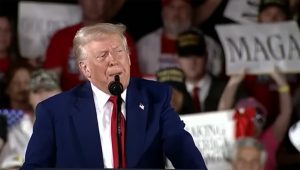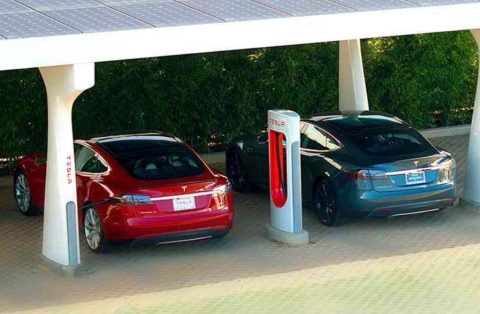A U.S. District Court judge has ordered the White House to release about $1 billion in funds set aside for the construction of a nationwide public EV charging network. The funds were frozen by Pres. Donald Trump as part of his campaign to rollback Biden-era electric vehicle mandates. But the administration is still pressing Congress to drop other EV programs, including federal tax credits of up to $7,500, reports Headlight.News.
Work may soon resume on setting up setting up a network of public EV charging stations after U.S. District Judge Tana Lin ordered the Trump administration to unfreeze $1 billion approved for that task by Congress as part of the National Electric Vehicle Infrastructure, or NEVI, program.
NEVI was intended to provide $5 billion for public charger construction and contracts for nearly half that amount had already been put in place. But, on his first day in office, Pres. Donald Trump signed an executive order pausing dispersement of any remaining funds authorized by the act,
Sixteen states, along with the District of Columbia, filed suit, alleging the freeze was illegal and Judge Lin freed the funding after saying she expected those states would win. The administration has until next week to resume distribution of the funds. But the White House is moving forward on other actions meant to eliminate federal support for EVs, among other things, by backing a Congressional budget bill set to eliminate current tax credits for EV buyers.
The lawsuit
Under Pres. Joe Biden, the executive brand and Congress took a number of steps to support the growth of battery-electric vehicles. One of the most critical moves saw $5 billion set aside for EV chargers as part of the infrastructure bill signed into law by the former president in Nov. 2021.
On his first day in office, however, Trump ordered the Sec. of Transportation to withhold any funds not already distributed or committed to with signed contracts. Republican governors in many states agreed to return cash they hadn’t yet spent but state officials in Washington, Oregon, Colorado, California, Arizona, Delaware, Hawaii, Illinois, Maryland, New Jersey, New Mexico, New York, Rhode Island, and Wisconsin, as well as the District of Columbia, filed suit, calling the freeze “unconstitutional.” They argued the Constitution did not allow the president to withhold funds already approved by Congress.
“He’s illegally stripping away billions of dollars for electric vehicle charging infrastructure, all to line the pockets of his Big Oil friends,” said California Attorney General Rob Bonta at the time the suit was filed.
The judge rules in favor of plaintiffs

The lack of a ubiquitous public charging network is seen as a major roadblock to widespread EV adoption.
The lawsuit has yet to go before the circuit court in D.C. but Judge Lin determined that plaintiffs’ claims will win out since the president’s executive order appeared to violate the Constitution’s separation of powers clause.
The ruling also noted that the states could suffer harm if an injunction weren’t granted. However, Judge Lin did not un-freeze funds for Minnesota, Vermont and Washington, D.C., saying they had not yet demonstrated “irreparable harm.”
California AG Bonta responded by saying, “We are pleased with today’s order blocking the Administration’s unconstitutional attempt to do so, and California looks forward to continuing to vigorously defend itself from this executive branch overreach.”
But Judge Lin stayed her order until July 1 in order to give the White House time to appeal her decision.
More EV News
- A Wave of Senior Execs Leave as Tesla Sales Plunge
- AMG’s GT XX Concept is a 1,340 EV
- Your EV Battery Likely Will Outlast Your Gas Engine
The battle over EVs
California, the White House and Congress are now locked into a number of legal battles, many of them focused on environmental matters.
The state has filed a lawsuit aimed at overseeing a recent measure passed by federal lawmakers – and since signed by Trump – stripping California of its ability to set unique emissions standards under the Clean Air Act. That authority was being used to set strict new guidelines effectively mandating a switch from gas and diesel to all-electric propulsion for both retail and commercial vehicles.
Trump also hopes to strip away the federal tax credits of up to $7,500 currently available for EV buyers. As now written, that incentive program has been defunded under the federal budget measure dubbed “The Big Beautiful Bill.” It has passed the House but is currently facing sharp debate in the Senate over such controversial moves as a sharp cutback in Medicaid. The elimination of EV credits is widely expected to be included in a final measure, however.









How many gas stations did the US government fund and build?
Jim, a little research would help get you past politics. The International Monetary Fund reports the U.S. is second only to China in subsidizing the oil industry is all sorts of ways, as the document excerpt, below, makes clear. All told, direct and indirect subsidies for fossil fuels run well past $100 billion annually. This is a 2019 report and the numbers are now significantly higher, with more proposed by the administration. A bit more research reveals there are a number of ways U.S. tax dollars supported the rollout of gas stations over the last century, as well.
Note that some of the numbers quoted by the IMF are up to debate. But even Forbes shows just how much the industry gets: “ Calculating the cost of U.S. subsidies for the fossil fuel industry is complex because the incentives stretch across the U.S. tax code, but estimates range from $10 to $50 billion per year.”
Those numbers are on an annualized and ongoing basis. NEVI is a one-time measure.
A new report by Fortune…not a bastion of the Left…reports: “
Governments pledged to end fossil fuel subsidies. Instead, they’ve doubled down since 2020, hitting record $1.3 trillion.”
I could load you with more but the median estimate for US subsidies of the oil industry run about $30 billion…if you don’t consider the military costs involved in keeping sea lanes clear.
Paul E.
Direct Subsidies
Intangible Drilling Costs Deduction (26 U.S. Code § 263. Active). This provision allows companies to deduct a majority of the costs incurred from drilling new wells domestically. In its analysis of President Trump’s Fiscal Year 2017 Budget Proposal, the Joint Committee on Taxation (JCT) estimated that eliminating tax breaks for intangible drilling costs would generate $1.59 billion in revenue in 2017, or $13 billion in the next ten years.
Percentage Depletion (26 U.S. Code § 613. Active). Depletion is an accounting method that works much like depreciation, allowing businesses to deduct a certain amount from their taxable income as a reflection of declining production from a reserve over time. However, with standard cost depletion, if a firm were to extract 10 percent of recoverable oil from a property, the depletion expense would be ten percent of capital costs. In contrast, percentage depletion allows firms to deduct a set percentage from their taxable income. Because percentage depletion is not based on capital costs, total deductions can exceed capital costs. This provision is limited to independent producers and royalty owners. In its analysis of the President’s Fiscal Year 2017 Budget Proposal, the JCT estimated that eliminating percentage depletion for coal, oil and natural gas would generate $12.9 billion in the next ten years.
Credit for Clean Coal Investment Internal Revenue Code § 48A (Active) and 48B (Inactive). These subsidies create a series of tax credits for energy investments, particularly for coal. In 2005, Congress authorized $1.5 billion in credits for integrated gasification combined cycle properties, with $800 million of this amount reserved specifically for coal projects. In 2008, additional incentives for carbon sequestration were added to IRC § 48B and 48A. These included 30 percent investment credits, which were made available for gasification projects that sequester 75 percent of carbon emissions, as well as advanced coal projects that sequester 65 percent of carbon emissions. Eliminating credits for investment in these projects would save $1 billion between 2017 and 2026.
Nonconventional Fuels Tax Credit (Internal Revenue Code § 45. Inactive). Sunsetted in 2014, this tax credit was created by the Crude Oil Windfall Profit Tax Act of 1980 to promote domestic energy production and reduce dependence on foreign oil. Although amendments to the act limited the list of qualifying fuel sources, this credit provided $12.2 billion to the coal industry from 2002-2010.
Indirect Subsidies
Last In, First Out Accounting (26 U.S. Code § 472. Active). The Last In, First Out accounting method (LIFO) allows oil and gas companies to sell the fuel most recently added to their reserves first, as opposed to selling older reserves first under the traditional First In, First Out (FIFO) method. This allows the most expensive reserves to be sold first, reducing the value of their inventory for taxation purposes.
Foreign Tax Credit (26 U.S. Code § 901. Active). Typically, when firms operating in foreign countries pay royalties abroad they can deduct these expenses from their taxable income. Instead of claiming royalty payments as deductions, oil and gas companies are able to treat them as fully deductible foreign income tax. In 2016, the JCT estimated that closing this loophole for all American businesses operating in countries that do not tax corporate income would generate $12.7 billion in tax revenue over the course of the following decade.
Master Limited Partnerships (Internal Revenue Code § 7704. Indirect. Active). Many oil and gas companies are structured as Master Limited Partnerships (MLPs). This structure combines the investment advantages of publicly traded corporations with the tax benefits of partnerships. While shareholders still pay personal income tax, the MLP itself is exempt from corporate income taxes. More than three-quarters of MLPs are fossil fuel companies. This provision is not available to renewable energy companies.
Domestic Manufacturing Deduction (IRC §199. Indirect. Inactive). Put in place in 2004, this subsidy supported a range of companies by decreasing their effective corporate tax rate. While this deduction was available to domestic manufacturers, it nevertheless benefitted fossil fuel companies by allowing “oil producers to claim a tax break intended for U.S. manufacturers to prevent job outsourcing”. The Office of Management and Budget estimated that repealing this deduction for coal and other hard mineral fossil fuels would have saved $173 million between 2012 and 2016. This subsidy was repealed by the Tax Cuts and Jobs Act (P.L. 115 – 97) starting fiscal year 2018.
Oh, and subsidies for oil industry go back to Nelson Rockefeller and before…and helped support the expansion of the service station network!
https://www.fsec.ucf.edu/en/about/pab/2012-02-10/longhistory-article.pdf